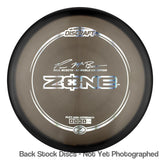What weight disc should I throw and how does weight affect the flight?
Understanding Disc Weight: How It Affects Your Game
A disc's weight is a critical aspect of its performance, and it's usually indicated on the bottom of the disc. Manufacturers employ various methods to display this information—some emboss or engrave the weight, others attach a small sticker, and occasionally you might find the weight handwritten with a pen or sharpie. The weight is typically given in grams and can appear as an exact value or a range (for example, "173-5" would be about 174 grams).
Weight Ranges
Disc weights generally fall into a few categories:
- Standard: 160g to 180g
- Lightweight or "Air": 145g to 165g
-
150 Class: 110g to 159g
These ranges help players quickly understand where a disc sits in terms of heft and potential flight characteristics.
PDGA Regulations and Performance
Disc weight is regulated by PDGA rules, which set maximum weights based on the disc’s diameter. For instance, drivers are typically limited to 175 grams, while wider, slow-speed discs can go up to around 180 grams. With a perfect throw and a strong arm, heavier or maximum-weight discs tend to be the best choice, as their added mass makes them less susceptible to wind interference.
Choosing the Right Weight for Your Game
The right disc weight often depends on your grip strength. Unlike simply "releasing" a disc, a throw involves a tight grip that snaps the disc free. Here are a few guidelines:
- Average Recreational Players: Often find success with drivers weighing between 165 and 170 grams.
- Experienced Players: May prefer using the full 175 grams for added stability and power.
- Young or Beginner Players: Typically benefit from lighter discs, which are easier to control and less likely to cause premature releases.
One clear sign that a disc might be too heavy is an early release—when the disc slips from your fingers before you’ve fully committed to the throw. An early release often results in a hyzer or "pre-faded" angle, leading to reduced power and inconsistent flights. If you experience this, switching to a lighter disc might solve the problem.
Adjustments in Disc Manufacturing
Manufacturers sometimes incorporate tiny air bubbles during the molding process to adjust a disc’s weight. These bubbles reduce the overall density, which can even enable the disc to float in water—a potentially handy feature if you often play near water hazards. However, it's wise to test this characteristic beforehand, as not all discs will float as expected.
Final Thoughts
Selecting the right disc weight is a balancing act influenced by your physical strength, throwing style, and the environmental conditions you face on the course. Experimenting with different weights can help you find the perfect match for your game. For younger or newer players, starting with lighter discs can foster better technique and control as you build up your skills.
With the right balance in hand, you’ll be set to improve your consistency, power, and overall performance on the course.













Laissez un commentaire